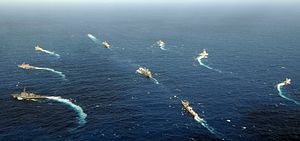India, the United States, and Japan are set to hold week long war games in the Pacific Ocean starting this Friday. Warships from the three countries will begin the joint exercises after an official opening ceremony at U.S. Fleet Activities Sasebo, a naval base located near Nagasaki, Japan.
The Malabar Exercise, as this exercise is called, is normally an annual bilateral naval exercise involving India and the United States. The exercise mainly focuses on anti-piracy and anti-terrorism operations. India invited Japan to participate in the exercises earlier this year, a reflection of the increasingly close relationship between the two countries. The Prime Ministers of both countries, India’s Narendra Modi and Japan’s Shinzo Abe get along well. They are known to be of like mind on a variety of economic and security issues. Modi is set to visit Japan sometime in August or September.
Japan’s participation, however, is bound to ruffle feathers in China, as it did in 2007 and 2009, the last two times Japan also participated in the Malabar Exercise. While India is keen on strengthening relations with Japan, it is wary of being seen as part of an alliance designed to contain China. However, despite attempts by both countries to improve relations, there are enduring tensions over an unresolved border dispute. This means that India will continue to cultivate a closer security relationship with Japan. According to C. Raja Mohan, a former assistant chief of India’s naval staff, “India is hedging its bets by taking its relations with both China and Japan forward.”
India and Japan have previously participated in multilateral naval exercises in the past as well as holding the bilateral JIMEX 12 exercise in 2012. According to analysts, India’s decision to invite Japan to participate in this year’s exercises signals a more confident and forceful maritime policy. Additionally, it shows that India is becoming more open to the idea of collective military action.
This year’s exercises will take place in two phases. The harbor phase will last between July 24 and July 26 while the sea phase will take place between July 27 and July 30. Three Indian warships, with 800 men will be taking part in the exercises. The Indian warships are on a long overseas deployment under the command of fleet commander Rear Admiral Atul Kumar Jain. The three Indian warships have previously taken part in an exercise with Russia off the coast of Vladivostok earlier this month.
The three Indian warships participating in the exercise are guided-missile destroyer INS Ranvijay, stealth frigate INS Shivalik and tanker INS Shakti. Two Japanese destroyers are participating as escort ships. On the other hand, several ships from the U.S. Seventh Fleet are taking part in the exercises.
The prevailing belief is that closer cooperation between the navies of Japan, India, and the U.S. will ensue as a result of these exercises. This assists the U.S. Pivot to Asia as well as the security preparedness of the Indian and Japanese navies.

































